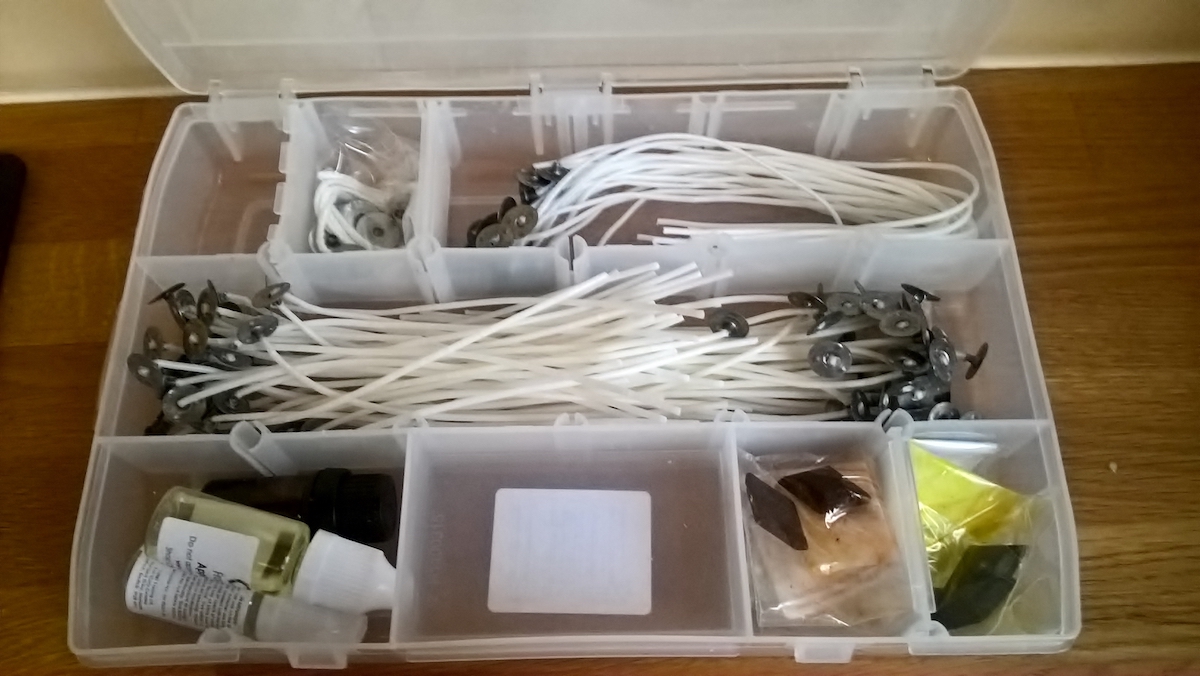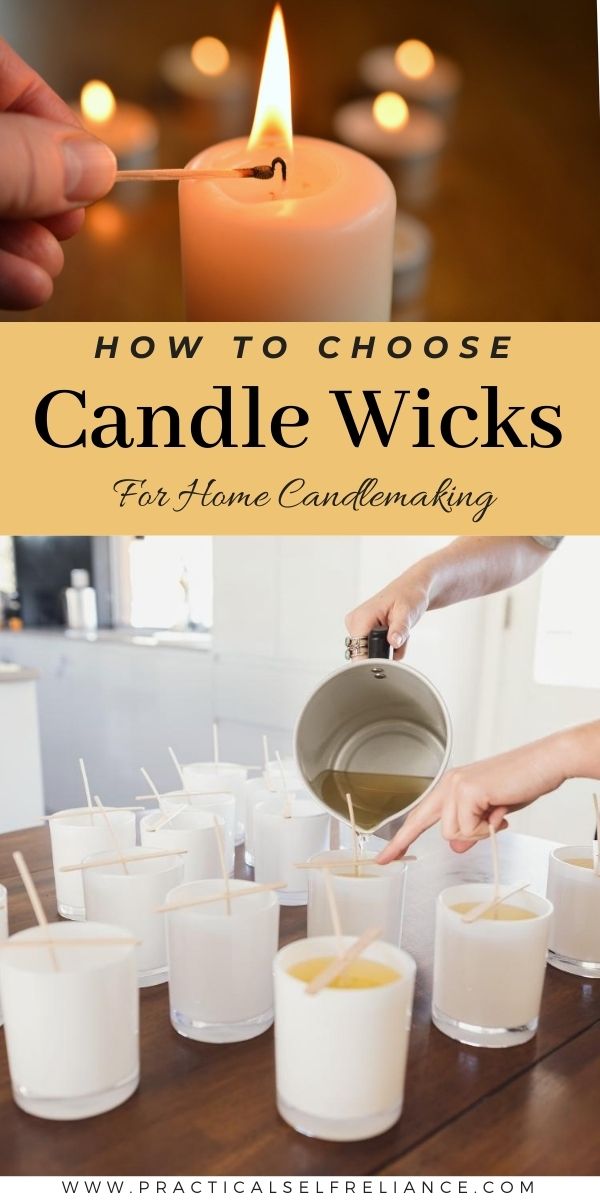Affiliate disclosure: This post may contain affiliate links. Please see our Privacy Policy.
Choosing the best candle wick for your handmade candles can be confusing for beginners and as well as even more advanced candle-makers; this guide breaks down the most popular kinds of wicks and how to use them.

While candle wax might be the first thing that comes to mind when you think of making handmade candles (it’s definitely the most exciting component), the choice of wick is equally as important.
The information I’ve included below is a great place to start learning about all the different types of candle wicks available, as well as tips for troubleshooting common wick-based conundrums.
How to Choose a Candle Wick
Learning how to choose a candle wick is a science, but there’s also an intuitive component — you’ll find there’s a lot of trial and error when you’re making candle at home. Stick to small candles in the beginning, 4-ounce mason jars are perfect, and make lots of notes along the way.
Not only will you save a ton of wax and time, but you’ll familiarize yourself with the candle-making process at the same time.
Another useful tip for choosing the right wick is to follow the directions provided by the wax manufacturer. While you might have to to experiment with a few sizes, the accompanying directions to buying wax are usually both helpful and accurate.
When you’re researching candle wicks, you’ll need to go through the following checklist:
- Type of wax (can include paraffin wax, soy wax, coconut wax, palm wax, gel wax, and beeswax)
- Type of candle
- Size and shape of candle
- Wax melting point
- Fragrance (if using) and percentage
- Type of colorant (if using) and percentage
- Additives
- Expected wax consumption
When you’re first getting started, it can be helpful to use a “wick generator.” The information it gives you is based on the type of wax being used and the size of the candle container, and is an ideal starting point for choosing and experimenting with various wicks.
Types of Candle Wicks
Most types of candle wicks belong in one of three main categories:
- Cored wicks: Braided or knitted wicks which encase a round core made from paper, cotton, zinc, or tin.
- Flat wicks: Flat-braided or knitted wicks that are typically made from three layers of fiber; known for being self-trimming and having a consistent burn.
- Square wicks: Self-trimming wick that can be braided or knitted; are often used with beeswax (for poured candles and taper candles).
Within these three categories there are several different kinds of wicks:
Zinc Core Wicks
- Widely used for many different types of candles, including gel candles, votives, tea lights, and molded candles.
- Made from a cotton braid with a zinc core (the sturdiest core material), which keeps the wick rigid and upright as is burns.
- Zinc core wicks burn cooler, making them best for paraffin wax, soy wax, or a blend.
- You can find a detailed guide to using zine core wicks here.
Paper Core Wicks
- Widely used for many different types of candles, including votives, tea lights, and molded candles.
- Made from a cotton braid with a paper inner core, which gives the wick more rigidity.
- Paper core wicks burn cooler and are best for paraffin wax, soy wax, or a blend.
- Check out these charts to see which paper core wick is best for your candle.
ECO Candle Wicks
- Designed for use with natural waxes and used for many different types of candles, including votives, tea lights, molded candles, and container candles up to 7 inches in height.
- ECO wicks are flat and made from a coreless cotton braid that has been blended with paper.
- Have been engineered so that the wick is self-trimming and less prone to mushrooming, soot, and smoke as it burns.
- Burns cooler and is primed with soy wax so is best paired with soy wax (perfect for an “all natural” candle option) or a soy/paraffin blend.
- For more information about ECO wicks and a helpful chart, check out this guide here.
Stabilo/CD Candle Wicks
- Widely used for many different types of candles, including votives, tea lights, molded candles, and container candles.
- Stabilo/CD wicks are flat and made from a coreless cotton braid that has been blended with paper.
- The combination of cotton and paper in the wick is perfect for candles with high fragrance loads (a fragrance load, according to All Seasons Wax Company, “simply means the percentage of fragrance you’ll mix into your jar along with your candle wax, it is always expressed as a percentage.”)
- Best for paraffin wax, soy wax, and other vegetable base waxes.
- For a stabilo/CD wick and container size chart click here.
HTP Candle Wicks
- Can be used for all types of candles, including votives, tea lights, container candles, and molded candles.
- HTP wicks are a flat, self-trimming, and rigid wick made from cotton and paper that has been woven together.
- A good option for candles made with several types of additives or that are difficult to burn.
- Best for paraffin, soy wax and other vegetable waxes, and gel wax.
- To look at an HTP candle wick and container size chart, take a look at this guide.
LX Candle Wicks
- LX wicks are ideal for making candles that require pouring, such as votives, molded candles, and container candles up to 5 inches tall.
- Flat braided wick means the flame is more controlled, so that melted wax doesn’t tunnel or spill over the container as the wick burns.
- Use with paraffin wax, soy wax, or other vegetable-based wax.
- You can find more information about sizing LX candle wicks here.
There are also two types of wick made from all-natural materials, hemp wicks and wooden wicks:
Hemp Wicks
- Can be used for votives, tea lights, molded containers, and container candles up to 7 inches tall.
- Made braided braided hemp (look for unbleached hemp wicks if possible)
- Hemp wicks are quite rigid, burn hot, and give off very little smoke.
- Ideal for use with all types of waxes.
Wick guides can be confusing for beginners (and even more advanced candle makers) to follow, which is why I love having someone demonstrate the differences as well as the pros and cons of each type of wick in video form.
Wooden Wicks
- Can be used for votives, tea lights, container candles, and molded candles, but the candles should be free of decorations or add-ins to reduce the risk of fire.
- Wooden wicks are made of unwaxed/unoiled thin tubes or flat slabs of wood.
- Are well-known for the crackling, cozy sounds the wicks produce as they burn.
- Can be used with any type of wax, including beeswax and wax blends.
Wooden wicks, which are available in both hard and softwood, differ the most from the other wicks in terms of material, testing, and usage. This helpful video goes into greater detail about choosing and testing the best wooden wick for your candle:
Can You Wax Your Own Wicks?
With such a massive variety of pre-waxed wicks to choose from, it’s a lot more convenient to buy wicks primed and ready to go. Waxing your own wicks isn’t too difficult, however, it’s more time consuming than anything else.
It’s a fun activity though, especially as a homeschool activity with kids, and as this tutorial shows, it’s possible to prime wicks in colored waxes instead of the usual white.
Beginning at 6:42, this video provides instructions for waxing your own wicks using cotton string and two pours of melted beeswax, resulting in wicks that can be used with a variety of different natural waxes and candle types:
Troubleshooting Candle Wicks
Tunneling
- It’s important to point out that tunneling, which occurs when wax forms a tunnel around the wick, can happen with candles that have been poured or made correctly and is dependent on achieving a full burn across the surface of the candle more than anything else.
- If this problem continues to persist across all the candles you make, you might try making future candles with a wider wick.
Drowning Candle Wick
- If the cause is related to the wick, it could mean that the wick is too small for the container/candle size.
- Could also be a result of overfilling the container with wax.
Flickering Flame
- Usually means the candle wick is too long, which leads to a large, too-hot flame.
- Try this: extinguish the candle flame and trim the wick; if the same flickering immediately appears the wick size is incorrect.
Mushrooming Wick
- A mushrooming wick occurs when the wax in the candle isn’t able to burn fast enough to keep up with the wick that you have chosen.
- In most cases, the cause is a wick that’s too big. Try trimming the wick so that’s it’s shorter and molding it so that’s it sits straight above the wax.
Smoking Wicks
- Usually a sign that the wick is too large, as a too-large wick will burn up more melted wax than the wick can burn.











